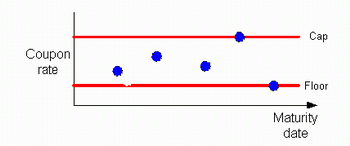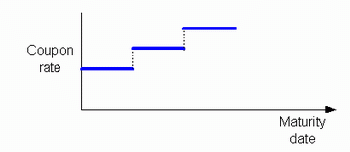Do you want BuboFlash to help you learning these things? Or do you want to add or correct something? Click here to log in or create user.
Subject 4. Structure of a Bond's Cash Flows
#basic-concepts #cfa #cfa-level-1 #fixed-income #has-images #reading-52-fixed-income-securities-defining-elements
Principal Repayment Structures

For example, an inverse floater's coupon rate = 12% - 2 x 3-month LIBOR. If the three-month LIBOR is 2%, then the coupon rate for the next interest payment period is: 12% - 2 x 2% = 8%.
Bullet bond. The issuer pays the full principal amount at the maturity date.
Amortizing bond. Its payment schedule requires periodic payment of interest and repayment of principal. If the entire principal is not amortized over the life of the bond, a balloon payment is required at the end of the term.
A sinking fund arrangement allows a bond's principal outstanding amount to be repaid each year throughout the bond's life or after a specific date.
A call provision is the right of the issuer to retire the issue prior to the stated maturity date. When only part of an issue is called, the bond certificates to be called are selected randomly or on a pro rata basis.
Coupon Payment Structures
The coupon payments of a floating rate security are reset periodically (e.g., quarterly) according to a reference rate such as LIBOR.
Example
Suppose that the reference rate is the 1-month LIBOR and the quoted margin is 100 basis points: if the 1-month LIBOR on the coupon reset rate is 5%, the coupon rate is 5% + 100 basis points = 6%.
The quoted margin does not need to be a positive value. For example, it could be -90 basis points.
A floating-rate security may have upper and/or lower limits on the coupon rate. A cap is the maximum coupon rate of a floater. It is an attractive feature for the issuer since it limits the coupon rate. A floor is the minimum coupon rate, and it is an attractive feature for the investor. A collar is a floater with both a cap and floor.

For example, assume the reference rate is the 1-month LIBOR, the quoted margin is 100 basis points, and there is a cap of 7%. If the 1-month LIBOR at reset date was 6.5%, the coupon rate per the formula would be 7.5% (6.5% + 1%), but with the cap the coupon rate is restricted to 7%.
A typical floater's coupon rate increases when the reference rate increases and decreases when the reference rate decreases. However, an inverse floater's (also called a reverse floater) coupon rate moves in the opposite direction from the change in the reference rate: coupon rate = K - L x reference rate, where K and L are constant values set forth in the prospectus for the issue. To prevent a negative coupon rate there is a floor imposed.
For example, an inverse floater's coupon rate = 12% - 2 x 3-month LIBOR. If the three-month LIBOR is 2%, then the coupon rate for the next interest payment period is: 12% - 2 x 2% = 8%.
Step-up coupon bonds have low initial and gradually increasing coupon rates; that is, their coupon rates "step up" over time.

Stepped spread floaters. The quoted margins for these coupons can step to either a higher or a lower level over the security's life. For example, a five-year floating-rate note's coupon rate may be six-month LIBOR + 1% for the first two years, and three-month LIBOR + 3% for the remaining years.
Credit-linked coupon bonds. These coupons change when the issuer's credit rating changes.
Payment-in-kind coupon bonds. These coupons allow the issuer to pay coupons with additional amounts of the bond issue rather than in cash.
The payment structures for index-linked bonds vary considerably among countries. An inflation-linked bond or linker links its coupon payments and/or principal repayments to a price index. For example, the Treasury Inflation Protection Securities' (TIPS) coupon is based on inflation rate: coupon rate = rate of inflation + quoted margin. The index can even be a stock market index.
If you want to change selection, open original toplevel document below and click on "Move attachment"
Summary
| status | not read | reprioritisations | ||
|---|---|---|---|---|
| last reprioritisation on | suggested re-reading day | |||
| started reading on | finished reading on |
Details
Discussion
Do you want to join discussion? Click here to log in or create user.